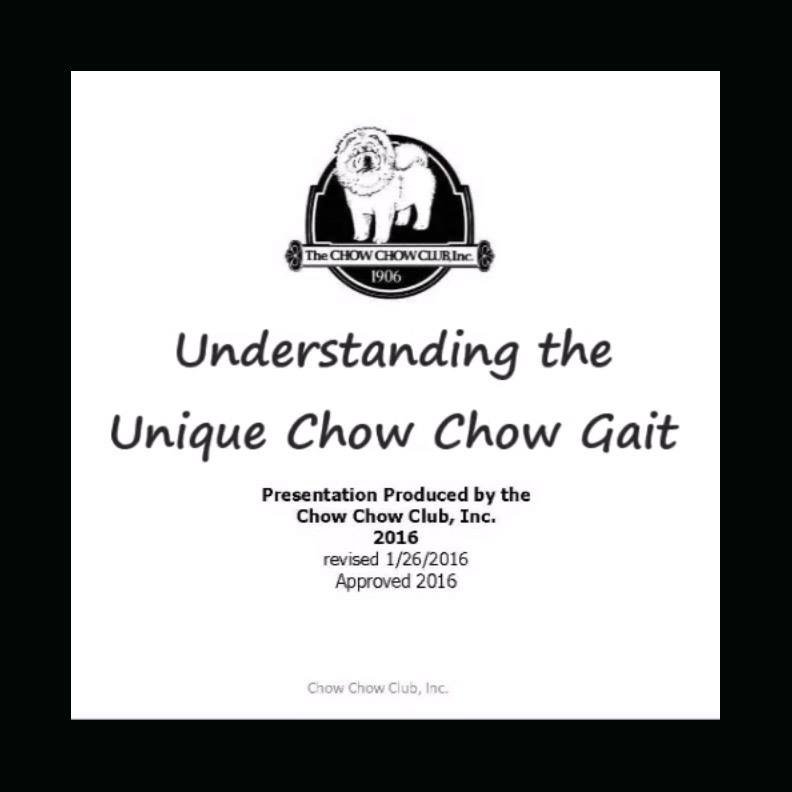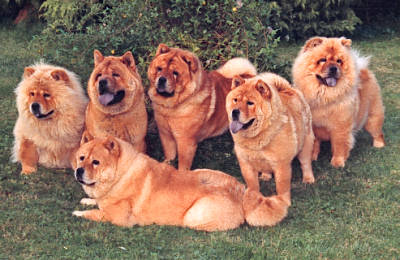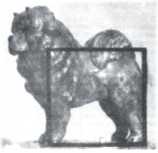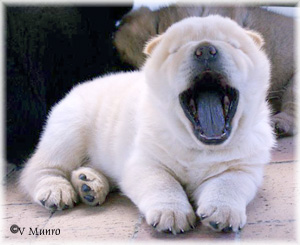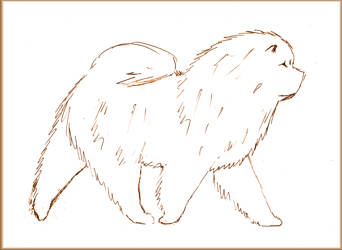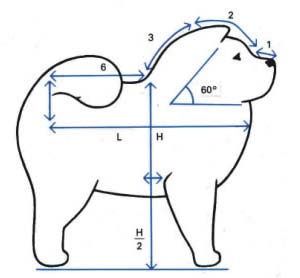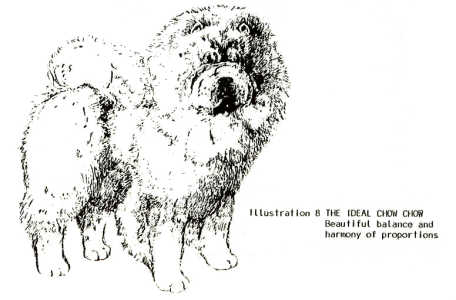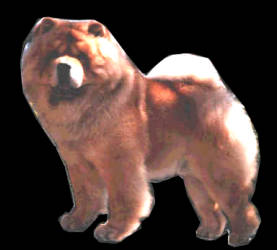Chow Chow Africa education
Best for the breed -
breeders And Judges Education

Pigmentation of the Chow Chow
by Bernice Leroy, Ciao Chows, South Africa
This article serves as an overview of the correct pigmentation for the Chow Chow to guide breeders and judges. We will approach each of the important anatomical points related to pigment by looking at, firstly and most importantly, what history tells us. We will then look at various Breed Standard requirements, after which we will compare it to genetics and interpret it all reasonably through these three filters.
Modern breeders and judges claim their goal to be preservation of the Chow Chow as it was historically manifest. In order to achieve this, as many historical records as possible - including the oldest possible (from East and West) - must be used as reference. One of the oldest of these Western records is the 1895 UK Breed Standard.
Breed Standards provide important benchmarks, meant to enshrine breed defining characteristics and protect the historical ideal against the tides of prevailing fashion, sentiment or prejudice. Breed Standards may contain wording which requires clarification and adjustment due to expanding knowledge in the field of genetics, new historical archives becoming available, or better phrasing so as to assist modern breeders pursue responsible custodianship, etc.
Knowledge of genetics is constantly growing, though many aspects remain unclear. Genetics help us integrate historical references with Breed Standards in order to preserve the foundational virtues of this ancient breed.
(Note:
Cream appears as a recessive, not dominant, trait, irrespective of the manner in which the colour is expressed in individual Chows. For the purposes of this article:
– a solid cream refers to a cream where the lips are black, the tongue is dark blue, the flews and palate are dark grey, eyes are dark brown and the eyerims are black (irrespective of the nose colour);
- a dilute cream refers to a cream where the lips are blue/grey, the tongue is a medium blue, the flews and palate are medium-light grey, eyes are medium brown and the eyerims are blue-grey to slate (dark grey) (irrespective of the nose colour). All cream chow chows have pink gums )
Eyes:

Foundations - what history and the oldest records teach us:
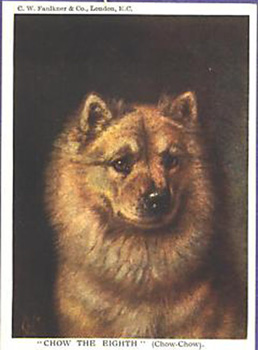
References mention very dark eyes. Sometimes eyes are described as black, which is not possible, although it may appear so on very dark brown eyes, due to the smaller eye, lighting conditions, etc. The darkest eyes are usually associated with black and red dogs. Fawn, blue, and even cream dogs, are described with lighter eye colours being natural and acceptable.
1895 UK Breed Standard: Eyes – Dark and small (In a blue dog light colour is permissible.)
There is a difference between the original appearance of Chow Chows and what we want them to be as described in the Standard. In that light this quote of Miss J.O.Joshua is an interesting one. (A Meulstee)
Chows – A Question of Colour
March 5 1948
“Miss J.O. Joshua writes that she has been taking an interest in Chows since 1922 or 1923 and remembers going to an L.K.A. show in Holland Park and can recall seeing Ch Hildewell Ba Tang. She naturally recalls Ch Pusa of Amwell who, she remarks, had a lightish eye, as had Ch Peng Tse of Amwell, Ch Choonam Brilliancy and Ch Choonam Tswee Tsong and remarks that when the craze for black boot button eyes started, she doesn’t know.”
Phenotype - what the modern Breed Standards say:
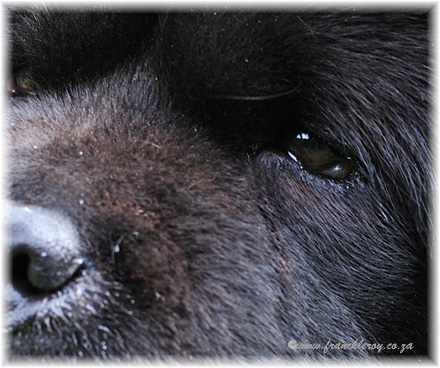
FCI/UK/RSA: Dark … a matching coloured eye permissible in blues and fawns.
USA: Dark brown …The eye rims black …
ANKC/NZKC: Dark … in blue or fawn dog a light colour is permissible.
CKC: Eyes dark …
UKC: Eyes are dark brown …

Correct medium brown eye on a blue. Under different lighting conditions this eye will seem to be dark brown.

Amber eye on a fawn, with commendably dark nose and good mouth pigmentation.
Genotype - what genetics dictate:
It is genetically possible to maintain the Breed Standard requirements for dark brown eyes on black, solid cream and red Chow Chows. Eyerims must be black on all three of these colour varieties.
By currently understood genetic information, blue, fawn and dilute cream dogs cannot have as dark brown eyes as red, black and solid cream dogs. This is due to the expression of the dilution gene they carry. Due to lighting conditions or other influences, deep seated or smaller eyes in the dilute Chow Chow may appear very dark to a casual observer – which may have led to Breed Standard wording being limited on this point. Thus, until worded more clearly, where Standards call for dark brown eyes in general, it should be interpreted that in dilute coloured dogs, the permissible eye colour may pale to a medium brown colour (dilution of dark brown).
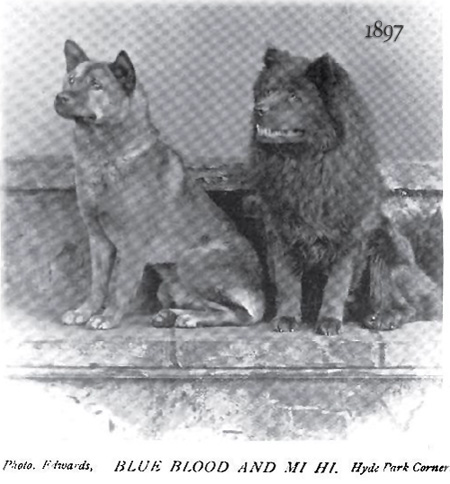
An unidentified smooth sitting next to blue rough Ch Blue Blood - which is manifesting the lighter eye on a blue.
Allowance is made also for amber eyes (shades of amber are light brown, yellow, yellow-green and grey) as this appears to correlate with the dilution gene. Eyerims must be blue/grey or slate (dark grey) - again, the dilution of black - on all three of these dilute colours. Until sufficient DNA colour profiling is done and the information pooled for research, there is no genetic proof that the gene for eye pigment is bound to colour of coat, pigment of tongue, eye, nose, lip or mouth, excepting for the effect of the dilution gene. Neither is there such proof that breeding dilutes with other colours produces lighter eyes on these other colours.
Whilst both history and standards allow for a lighter eye (see amber above) on dilutes, if such a light eyed chow chow is important to a breeding program due to other excellent qualities, it should be mated wisely – back to a solid colour chow with a lineage of dark eye colour.
Nose:
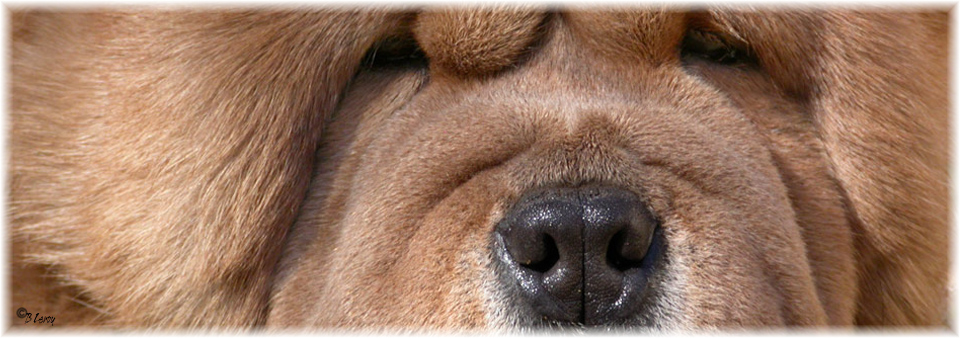
Foundations - what history and the oldest records teach us:
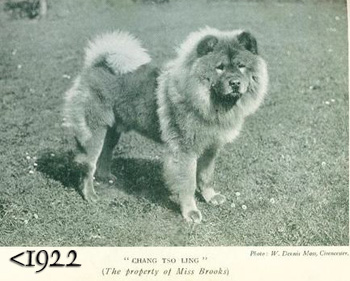
Left: From the book - "The Chow Chow"
by Lady Dunbar of Mochrum (1922)
Nose leather is generally described as black when referring to black or red Chow Chows. Records from the time of the Chow Chow’s earliest presence in the west refer to blues having blue/slate noses, fawns having grey, and even a darker fawn nose - ie darker brown nose, and creams having a light/red nose.
1895 UK Standard:
Nose – black, large and wide (in cream or light coloured specimens, a pink nose is allowable).
Disqualifying points – red nose except in yellow or white specimens.
Phenotype - what the modern Breed Standards say:

FCI/UK/RSA: … black with exception of cream and near white, in which case a lighter coloured nose is permissible, and in blues and fawns a self-coloured nose (but black preferable in all cases).
USA: … black in color… Disqualifying Fault – Nose spotted or distinctly other color than black, except in blue Chows which may have solid blue or slate noses.
ANKC/NZKC: Nose black …with the exception of cream and white in which case a light-coloured nose is permissible and in blues and fawns a self-coloured nose, but in all colours a black nose is preferable.
CKC: In blue or cream, black noses are preferred, but blues may have a slate coloured nose and creams may have a brown or liver coloured nose. In all other colours the nose must be black.
UKC: The nose is black in color except in blue-colored Chows who may have solid blue or slate noses.
Disqualifications: Nose spotted or any other color than those allowed.
Genotype - what genetics dictate:
It is genetically possible to maintain the breed standard requirements for black noses in black and red Chow Chows.
Breed Standards which call for “black preferable in all cases” call for what is, at this point in time, believed to be a genetic impossibility. Due to lighting conditions and other influences, some dilute Chow Chows may appear to have black noses and this may have led to such wording. However, by currently understood genetic information, blue and fawn cannot have black noses due to the dilution effect of these genes. Blues will have blueish-grey to slate (dark grey) noses, and fawns will have slate (dark grey) noses. Bearing in mind genetics and history, where Breed Standards call for a self-coloured nose in fawns, it does not mean a liver gened dog (chocolate). It is a dilution of a red dog and its pigmentation genes. Thus a matching colour nose in fawns should correctly be interpreted as a slate grey nose (dilution of black).
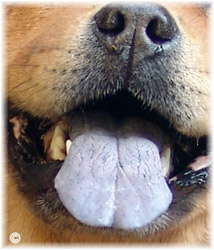
Note: Brown noses occur very occasionally in red and fawn dogs. Whilst this is not the same as the liver gene, it is not well understood yet. If such a Chow Chow is bred, it should be bred very cautiously – preferably back to black – to strengthen the all-important dark pigment.)
Picture:
Red with a brown nose, good solid colour tongue, generally black mouth pigmentation (differentiating it from a chocolate) splashed with pink on the gums & flews.
Cream Noses:
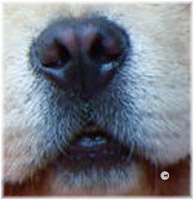
A typical dudley nose on a solid cream under 12 months - on the vast majority of creams this nose will manifest more pink in later years.
Cream Chow Chows have either brick-red noses (a dull brick brownish red with either black or blue/grey outlines) or the commonly termed ‘dudley’ noses (splashed pinkish/brownish red interspersed and outlined with black, or interspersed and outlined with blue/grey) – which is not the same as a ‘snow/winter nose’ or a ‘butterfly nose’.
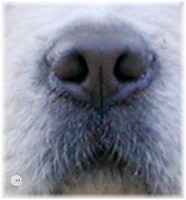
A typical dudley nose on a dilute cream - under 12 months - on the vast majority of creams this nose will manifest more pink in later years.
Anecdotally, and likely historically, very occasionally a cream may present with a solid black nose throughout its life. Such Chows should ideally be submitted for DNA profiling to both verify parentage and provide important DNA colour information so that they can be responsibly incorporated into breeding programs to retain this rare trait.
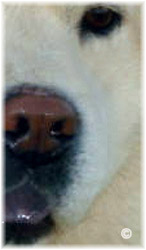
A typical brick-red nose on a solid cream, with commendably dark mouth and eye pigmentation.
The possible existence of Chows with solid black noses for their entire life would not exclude the historical correctness and allowance of the lighter nose on the cream. Until sufficient DNA colour profiling is done and the information pooled for research, there is no genetic proof that the gene for nose pigment is bound to the colour of coat, pigmentation of the tongue, eye, lip or mouth, excepting for the effect of the dilution gene. Neither is there such proof that breeding creams or dilutes with other colours produces noses with problem pigment on these other colours.
Lips/Flews/Gums/Tongue:
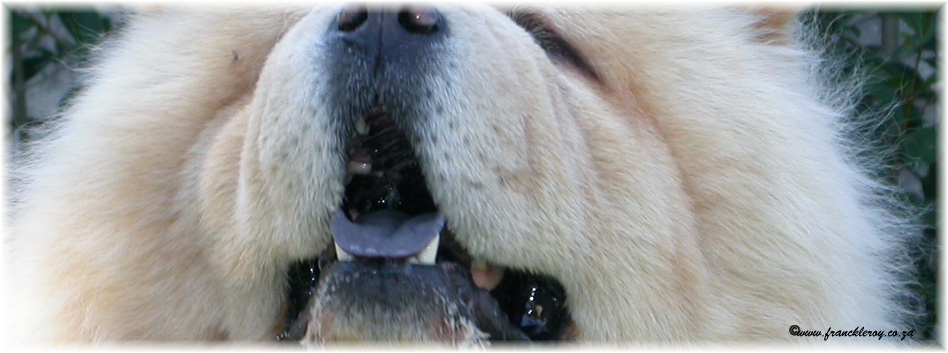
Foundations - what history and the oldest records teach us:
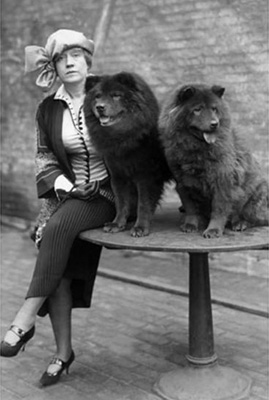
Few.references specifically mention lips, flews (mouth tissues) and gums separately. Lips, gums and palate are described as black when generally referring to red and black dogs. The tongue is repeatedly described as black, blue-black or blue (with “black” most likely so worded due to the perception created by lighting conditions). Pink present on the surface of the tongue is always referred to as highly undesirable and a disqualification in the show ring.
1895 UK Breed Standard:
Tongue – Black.
Disqualifying points – red tongue
In the Rev. Gilbert White's book 'The Natural History and Antiquities of Selborne' (1789), he makes mention of a young gentleman who "..brought home a dog and a bitch of the Chinese breed from Canton, such as are fattened in that country for the purpose of being eaten ... with coarse bristling hair on their backs ... their hind legs were unusually straight without any bend at the hock or ham, to give them an awkward gait when they trotted ... their eyes were jet black, small and piercing; the inside of their lips and mouths of the same colour as their tongues blue."
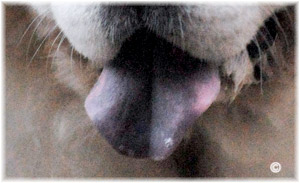
A tongue with pink splashes. It is interesting to note this 'faulty' genetic expression does not appear to be linked to the intensity of tongue colour - as such chows may have a generally light or a generally dark tongue (photo - a generally dark tongue)
Because historically the solid blue tongue is an unique and critical identifying characteristic of the Chow Chow, any Chow older than six months showing pink splashes on the tongue should be used in breeding only with the greatest amount of caution. For instance, if it has other much needed qualities within a limited genepool. The splashed tongue can quickly create great problems within a breeding line and even a country’s genepool. In the show ring, it should be penalized according to the Standard by which the Chows are being judged. Some Breed Standards disqualify outright, while others penalize the fault in relation to severity. Until sufficient DNA colour profiling is done and the information pooled for research, there is no genetic proof that the gene for tongue pigment is bound to colour of the coat, pigmentation of the nose, eye or lip/mouth colour excepting for the effect of the dilution gene, neither is there such proof that breeding specifically dilutes with other colours produces lighter tongues in these other colours.
Phenotype - what the modern Breed Standards say:

FCI/UK/RSA: A solid black mouth including the roof and flews, with a bluish black tongue is ideal. However, some dilution may be evident in the gums of blues and fawns and this dilution may be more pronounced in creams and whites.
USA: Edges of the lips black, tissues of the mouth mostly black, gums preferably black. A solid black mouth is ideal. The top surface and edges of the tongue a solid blue-black, the darker the better. Disqualifying Fault – The top surface or edges of the tongue red or pink or with one or more spots of red or pink.
ANKC/NZKC: Tongue bluish black. Flews and roof of mouth black. Gums preferably black.
CKC: Tongue is blue-black; the tissues of the mouth should approximate black. A solid black mouth and gums are preferred.
UKC: Lips, inner mouth tissue, and gums are black. The top surface and edges of the tongue are solid blue-black, the darker the better.
Faults: Lips, inner mouth tissue, or gums any other color than black, or spotted;
Disqualification: Top surface or edges of the tongue red, pink, or spotted with red or pink.
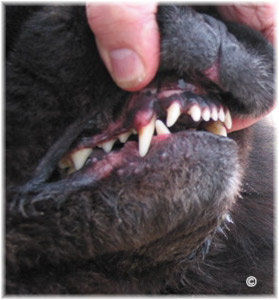 Where a red, black, blue or fawn adult manifests a measure of pink on the gums, it should be noted and if used for breeding due to other much needed qualities, be cautiously bred back to a dog with solid black gums and a lineage of solidly coloured gums.
Where a red, black, blue or fawn adult manifests a measure of pink on the gums, it should be noted and if used for breeding due to other much needed qualities, be cautiously bred back to a dog with solid black gums and a lineage of solidly coloured gums.
A black chow with pink on the gums.
Considered undesireable
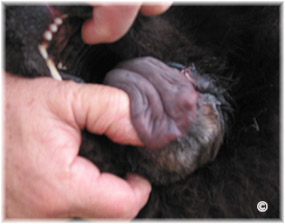
Tongue pigment can be undesireable on any colour. This black chow chow manifests undesireably light tongue colour for a black chow chow.
Genotype - what genetics dictate:
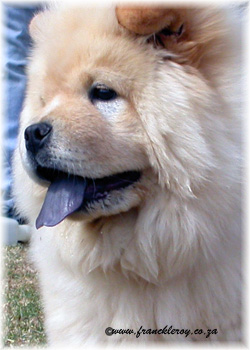
Whilst we have lumped them together here, as in the Breed Standards, the gene which dictates the tongue colour appears not to be genetically bound to that dictating the general mouth colour. The same applies to the gene for the lip colour. Thus one can have black lips on a cream Chow, with pink gums and a very dark tongue. Or dark grey lips on a fawn Chow with light blue gums but a good medium blue tongue. Or a red Chow Chow with some pink on the gums but a good dark tongue.
In not recognizing the influence of the dilution gene, some Breed Standards again call for what is currently understood to be a genetic impossibility - blue/fawns and creams having an equally dark tongue and black mouth tissues and gums as the reds/blacks. Due to lighting conditions and other influences, these dilute Chow Chows may appear to have darker mouths than they actually do and this may have led to the wording.
It is genetically possible to maintain the Breed Standard requirements for a solid black mouth (lips, flews, mouth tissues and roof of the mouth – palate) in black and red Chow Chows. In such Chow Chows, the tongue will manifest as a very dark blue. The solid cream Chow Chow can have black lips and a dark blue tongue equal to that of the red and black Chow Chows. However, the solid cream has a dark grey palate and flews and pink gums.
By currently understood genetic information, blue, fawn and dilute cream Chow Chows cannot have black lips. They will have dark blue/grey or slate (dark grey) lips. Their mouth tissue (flews) and palate will be a medium to light grey colour. Gums will be medium blue colour on blues and fawns, and pink on dilute creams. The tongue will be in the medium blue range on all three of these dilutes. Full depth of mouth pigmentation on the dilutes may only manifest as late as six months of age.

A blue with good tongue colour and dark blue nose, but with undesireable pink on the flews (inner lips) and gums
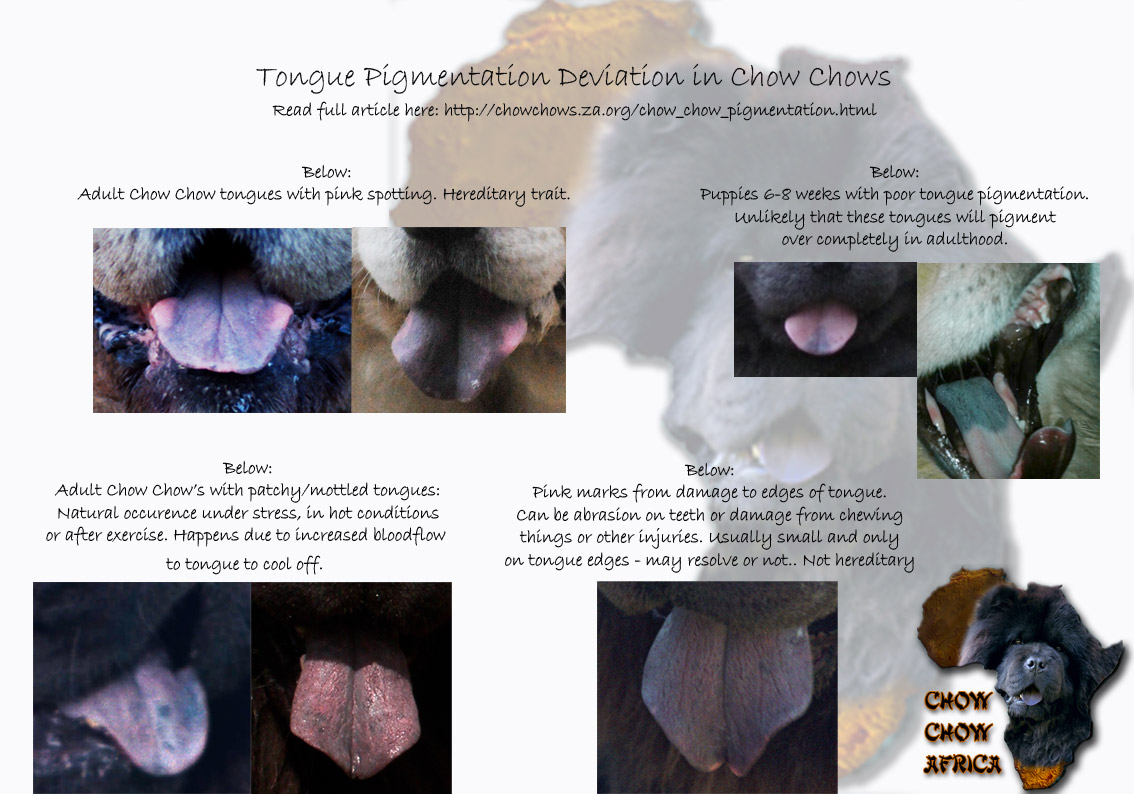
(Notes:
Tongue:
A Chow Chow may, after acquiring correct pigment with maturity, lose pigmentation on the surface of the tongue at the site of an injury, which pigmentation may not necessarily return. Older Chow Chows, particularly the dilutes, may gradually lose pigmentation along the edges of the tongue or on the lips where abrasion from the teeth occurs.
Nails:
Occasionally there have been broad references to dark and black nails in history. There is anecdotal reference to dark nails on all colours but cream, and to partially dark / light nails on dogs with excellent mouth pigmentation. Generally, pink / light nails are referenced in relation to creams. In none of the of the five colours does the gene for nail pigment appear to be genetically bound to that of coat, nose, tongue, eye, lip or mouth colour, excepting for the effect of the dilution gene.)
Wise Breeding:
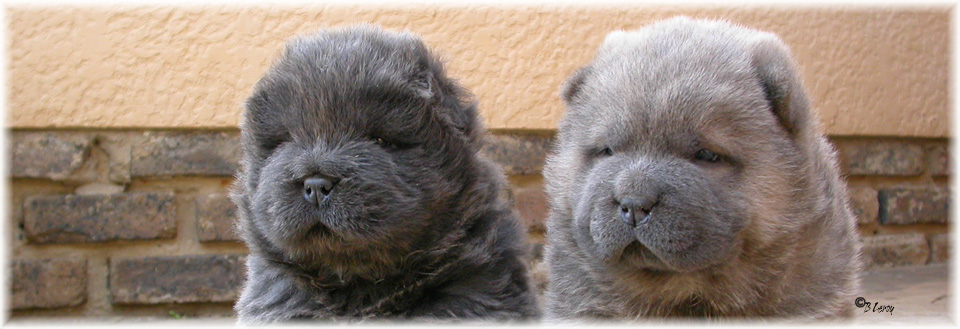
In the Chow Chows’ early history in the west, mention of colour differences is minimal, as is any specific mention of the smooth. Breeders were relatively few and for the most part considered these as just another Chow Chow. They were more focused on the type of the Chow Chow. With the passage of time and the proliferation of breeders came, of course, increased diversity of goals in breeding programs. Personal preferences and faddish demands from the puppy buying public made recessive colours popular and dictated the direction of a number of breeding programs. As acknowledged by many a seasoned exhibitor, the show ring prefers the reds, which has dictated the direction of some other breeding programs. When any program is followed without thorough understanding of pigmentation genetics, it risks damage not only to that breeding program, but certainly also to the future of the breeding pool of which it is part.
From the information above it is clear that it is not the incorporating of dilutes and creams into breeding programs as such, but the lack of understanding of pigmentation genetics which results in undesireable pigmentation. Therefore, it is vital that breeders accurately familiarize themselves with the genetics of pigmentation. For instance, tongue colour is apparently not tied to coat colour, pigmentation of nose or eye colour, therefore an attempt to improve tongue colour in a dilute Chow, by using a black Chow which itself (or its line) does not have very dark tongue pigmentation, though it may have excellent eye colour, black lips and a black nose, will fail. The same applies to correcting eye colour or general mouth pigmentation. Therefore, the breeder must be crystal clear what improvements exactly he/she is trying to realize. Establish whether a Chow has a generally very light or dark pigmentation, or if only some aspects of its pigmentation are more or less desirable. Research the depth of the more or less desirable pigmentation as far back as possible in the pedigree.
Chow Chow puppies are born with pink mouth pigmentation. Gradually between 1-5 weeks the tongue will colour over and mouth pigmentation will also darken. Pigmentation of the gums/mouth tissues may take a up to 18 months to reach full depth of colour.

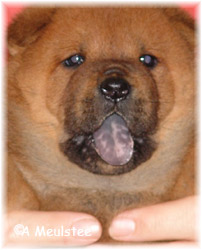
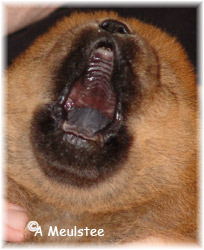
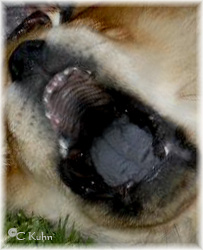
The dilution factor of the recessives does dilute pigmentation in dilute dogs and, when duplicated, it will continue to dilute pigmentation. This can be taken to an extreme where dark pigmentation is all but lost. Good pigmentation in the Chow Chow has been prized throughout history. For the benefit of the breed, therefore, it is important that dilutes not be bred together for more than a single generation, and then only those with good pigmentation, after which they must be taken back to solids.
When the occasional (or repeated) anomaly in terms of colour and pigmentation appears out of a pedigree with apparently normal pigmentation, it would be wise for the breeder to seriously consider having a DNA colour profile done (along with verification of parentage) and submitting results to those who are compiling a database and actively working with such profiles in Chow Chows. For instance, Chows which appear chocolate; lilac; red with a brown nose; cream with a completely black nose after eighteen months of age; black or red with light eyes; black born from red x red or red x fawn; etc. To assist us all, the individuals working with these databases are trying to better understand the particular genetics behind the Chow Chow by means of credible research.
Dr Sheila M Schmutz (PhD), University of Saskatchewan - http://munster.sasktelwebsite.net/DogColor/dogcolorgenetics.html
Dr Sue Ann Bowling, Alaska - http://bowlingsite.mcf.com/Genetics/ColorGen.html
(Note: In South Africa, Inqaba Biotec offers colour variation tests for the B, E and D loci but unfortunately not for the A, K or S loci. For more information, please visit the Inqaba Biotec website or contact Dr Henriette van der Zwan directly via the website.)
Wanting to publish these articles or link to them?
Some authors have given permission for these articles to be printed out for private free use internationally, both in national judges' training schemes and for private free education of individuals. However, all articles remain COPYRIGHT of the authors and no copies of these articles may be published in any way without written permission from the authors. For permission please contact the authors directly or please contact the webmaster.
On
the web, it will be appropriate to LINK to the articles which
originally appear on this website.
Acknowledgement of the articles' original appearance on this website
is appropriate and appreciated.
Breed Standards:
More Judging Articles:
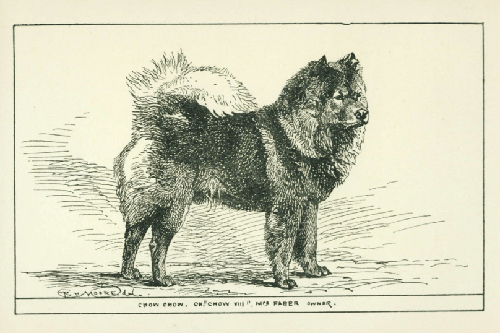 Learn more about the Chow Chow upon which the Breed standard is said to have been based.
Learn more about the Chow Chow upon which the Breed standard is said to have been based.
Learn about the Chow Chow's rich history on the Chow Chow Archives. This will help you understand the need for functional structure and moderate type.
